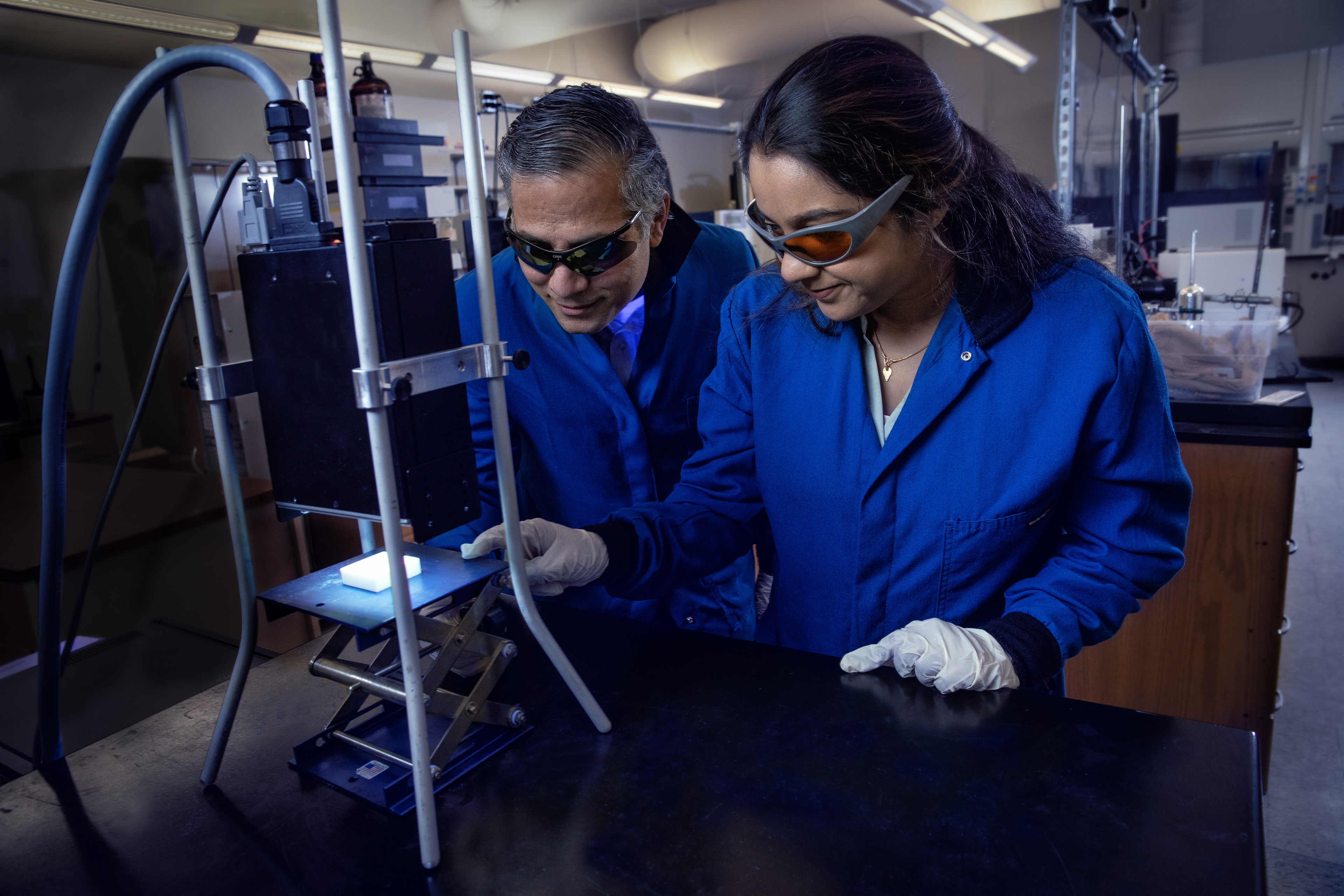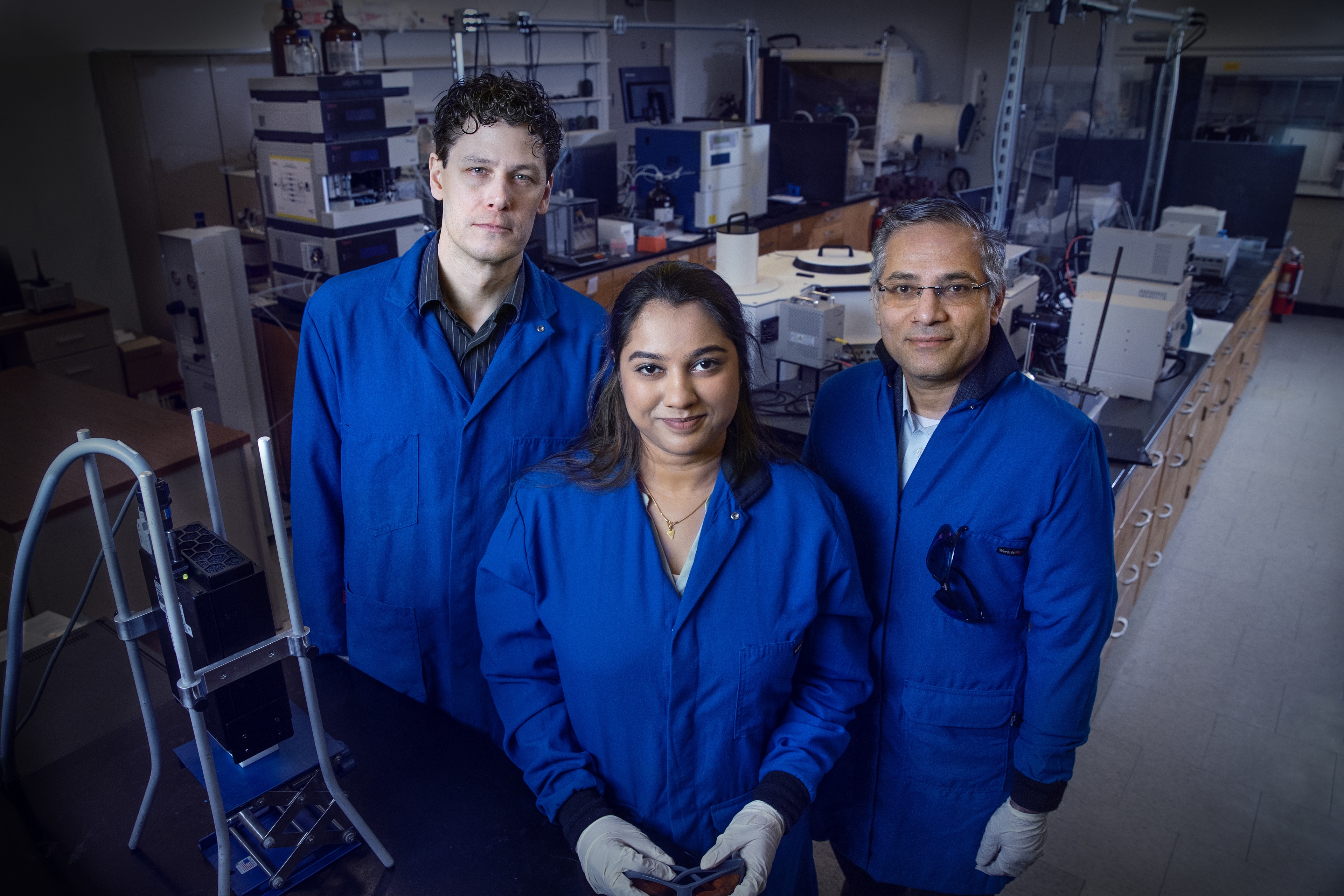
BGSU researchers’ bio-based photocuring technology garnering attention of top U.S. companies
Doctoral student assessing market viability as part of National Science Foundation entrepreneurial program
By Laren Kowalczyk '07
A new bio-based photocuring technology developed by a Bowling Green State University professor and graduate student is drawing the attention of top scientists at some of the country’s largest and most innovative companies.
Dr. Jayaraman Sivaguru, Distinguished Research Professor and associate director of the BGSU Center for Photochemical Sciences, and fifth-year doctoral student Sruthy Baburaj developed an eco-friendly compound that can be used in photocuring systems to strengthen surfaces on objects such as lenses, automotive coatings and semiconductors and is an alternative to traditional fossil-fuel-derived materials.
Through a grant from the National Science Foundation Innovation Corps (I-Corps) program, Baburaj presented the technology to more than 100 industrial professionals including many at Fortune 500 companies across the United States to assess its market viability.
“In many of the meetings, the scientists expressed significant interest in trying the technology,” said Baburaj, who is studying photochemical sciences at BGSU. “They told me there’s a need for our material and asked when it would be available for commercial use. It was inspiring to see that kind of response to our technology.”
The bio-based photoinitiator reacts with ultraviolet or visible light to rapidly transform a dispensable fluid into a robust solid material. Applications include resins for semiconductors, material formulations for automotive coatings and ophthalmic lenses, among many others. Its light source can be tailored based on the end user's curing process.
Sivaguru and Baburaj said their customizable technology offers numerous advantages over current methodologies, including its use of non-toxic materials, improved safety during manufacturing, sustainability, cost savings and high performance. The technology received a 2021 RadLaunch award from RadTech, a trade association for the UV + EB (electron beam curing technology) industry.

The I-Corps program aims to propel promising ideas to market through immersive, experiential training and help foster relationships between academic institutions and industry. Since NSF launched its I-Corps program in 2011, it has helped launch more than 1,000 startups.
As the entrepreneurial lead on the project, Baburaj traveled throughout the U.S., visiting various companies, including several on the Fortune 500 list, and gathering insights related to customer discovery for translating the developed research technology from the laboratory to market.
Sivaguru served as the project’s technical lead as the bio-based photoinitiator technology was developed from research conducted in his laboratory. Also as a part of the program, Baburaj was mentored by an industrial scientist, Dr. Greg Carroll, the director of research and scientific affairs at Aerobiotix, a medical device company in Miamisburg, Ohio.
The I-Corps program promotes close collaboration among the project's entrepreneurial lead, technical lead and industrial mentor to help bring cutting-edge technologies to market while nurturing an innovation ecosystem.
Baburaj said she gained valuable perspectives on industrial careers through the I-Corps program and established crucial connections, which will be beneficial as she prepares to graduate from BGSU in Spring 2023.
“Before this, I didn’t know how our work in the lab translated to industry,” Baburaj said. “I only knew what happened in the lab. Now, I have a clearer picture of the steps involved in taking research from the lab to companies for use in real-world applications.”
Sivaguru said the findings from the I-Corps team could serve as the foundation for a startup company based in Ohio.
"A program like this showcases how universities can be the cradle for new development that has a tremendous impact on our community and the world," he said. "These activities have their root in basic research. BGSU and the Center for Photochemical Sciences are ideal to lead this innovation due to our unique expertise in the areas of photocuring technology."
Related Stories
Media Contact | Michael Bratton | mbratto@bgsu.edu | 419-372-6349
Updated: 04/12/2023 01:54PM
